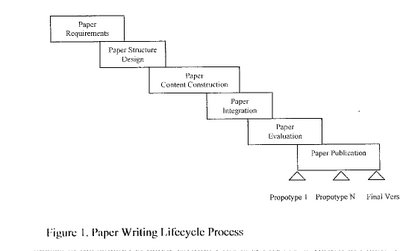Where shall I begin?

The White Rabbit put on his spectacles. 'Where shall I begin, please, your Majesty? he asked. Begin at the beginning the King said, very gravely, and go on till you come to the end, then stop.
Lewis Carroll, Alice in Wonderland
It is important to know (1) what will be your end-product and (2) who will be your end-user. In other words, I ask myself what I would like to see in my paper, who will be reading it, and what format is required (a journal article, conference paper, research thesis report etc). With this approach in mind, I then follow steps of an academic writing framework based on a System Lifecycle Process.
First of all consider your paper as an end-product. Find out what are the needs: (1) your needs as an author; (2) needs of the end-user (templates, specific conference themes, author’s manuals and guidance). After this, write your paper following the phases of the suggested Paper Writing Lifecycle Process as shown in Figure 1.

Phase 1 - Paper requirements
Translate needs in to specific requirements. For example: The paper shall be written in two columns because the journal requires this format.
Phase 2 - Paper structure design
Structure your paper. It should contain an introduction, a body with paragraphs, and a conclusion. Mind mapping tools like 'visual mind' and 'free mind' can help to draw a diagram of your paper.
Phase 3 - Paper content construction
This phase is the most challenging for non-native speakers as they transfer each of their thoughts and ideas from diagrams and bullet points defined during Phase 2 into logically structured academic paragraphs.
Think about each section separately, divide each section into small subsections and small paragraphs. A "style reuse" approach is suggested here by looking at the way other authors have constructed and worded sentences and learning from their styles.
Phase 4 - Paper integration
During this phase you integrate your separately written paragraphs into cohesive paragraphs.
Phase 5 - Paper evaluation
During this phase the paper should be "read aloud, given to a friend to proofread, and checked against your requirements from Phase 1.
Phase 6 - Paper publication/submission
This is the phase where you release your paper. That is, you publish your paper (if it is for a journal) or submit your paper if it is an assignment.
Instead of having a single release of the paper, I prefer to release multiple prototypes. In System Engineering a prototype release is a type of release when the customer gets a flavour of a working product with known limitations in its functionality.
Tim Ferris, in his blog entry, discussed perfectionism as one of the showstoppers of postgraduate students' abilities to write papers. If a paper is considered as an end product, the approach to deploy a draft version of the 'working document' will be highly beneficial for students and their supervisors.
Always keep the "end" in mind when you write your academic paper. Unlike the White Rabbit, you should not listen to the King!
Dr Elena Sitnikova with special thanks to Martin Kew and Bill Daniels for their valuable comments. Elena has Russian as her native language and, like an earlier posting by Dr Yan Zhuge , has passed on her approach for writing academic papers in English as a second language.
Illustration of the White Rabbit by Hudson in Carroll, L 1935 Alice in Wonderland, New York Dial Press Inc


0 Comments:
Post a Comment
<< Home